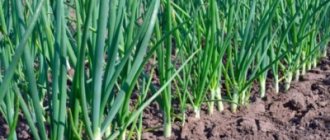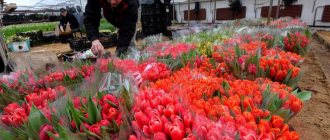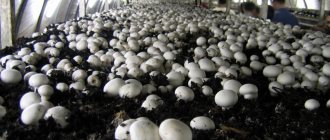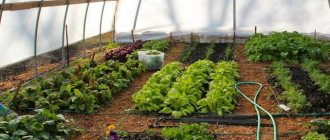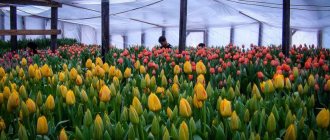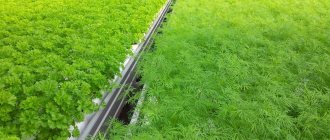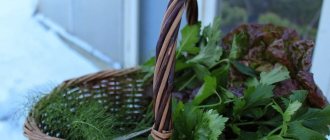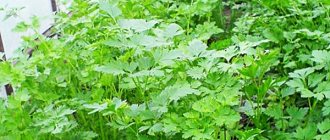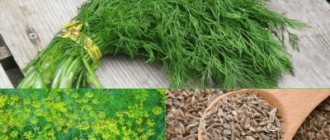Most gardeners begin the dacha season long before the snow melts and the first truly warm days: we grow seedlings, check the seed fund, purchase fertilizers and devices useful for dacha farming, and outline a plan for future plantings.
And far from the last place on this list of the very first things to do is growing early greens and vegetables in a greenhouse. If you already have a greenhouse, it would be a sin not to use it to the maximum. Already in mid-March, you can safely plant early cold-resistant crops, and during the May holidays, feed your family with a healthy salad of fresh vegetables straight from the garden. So what are the earliest vegetables? What can you plant in a greenhouse and have time to harvest before the “arrival” of the sovereign inhabitants of the greenhouses: tomatoes, peppers and eggplants? We'll find out now.
The main suppliers of the earliest greens and vegetables are our beloved cruciferous crops. Their remarkable property of increasing green mass in record time plays into the hands of lovers of fresh vitamins.
Watercress
A very early ripening plant, extremely rich in vitamins.
The watercress harvest is harvested 15-25 days after germination. This crop tolerates shade well and grows well in humid places. The main rules for growing watercress in a greenhouse are abundant watering and not too high a temperature (optimally 15-18°C). In too hot and dry conditions, the plant quickly becomes coarser, overgrows, and bolts. When the plants reach 6-8 centimeters, the watercress is ready for cutting.
Creating suitable conditions for a green garden
Greens are quite susceptible to climatic conditions and, if comfortable values are not observed, they will not produce healthy, strong shoots; they may even turn yellow and lose quality. Therefore, growing greens in a greenhouse, even for personal needs, is a labor-intensive task that requires compliance with general rules:
- The greenhouse structure must be installed on a foundation.
- For cladding, heat-insulating materials are used, for example, cellular polycarbonate.
- The room is equipped with a heating system.
- To provide plants with the necessary amount of light, artificial lighting is installed.
- Establish a high-quality ventilation system.
In addition, different types of greenery require a special temperature regime and type of soil, and specific care.
Greenhouse plantations with herbs are a great business
Radish
Our dearly beloved radishes also work well when planted in early spring.
Radish seeds can be scattered directly on the snow thrown onto the greenhouse ridges, and after 20-30 days you can enjoy the first root crops. For early planting of radishes, it is recommended to use special early-ripening spring varieties, and it is best to select only the largest seeds (plants with small seeds are more likely to grow into arrows). Radish is light-loving; it is preferable to grow it on the sunny side. And if you also dust the bed with ash before planting, which will provide the radishes with the necessary potassium, you will definitely not be left without a harvest.
For more information about the agricultural technology of growing radishes, read the article: Growing radishes: how to achieve a harvest
Types of greenhouses
Cultivation of greenery in winter can be carried out in different types of greenhouse structures. Read on for more details about each.
Mini greenhouse
This is an excellent option for gardeners who grow green mass for themselves in winter. Such a structure is installed in an apartment or other living space, and it looks like a large box under glass, inside of which there are small drawers filled with substrate. The seeds from which future crops will grow will be sown in these boxes.
In order not to burden yourself with preparing a large box, you can use an old aquarium.
This version of the greenhouse design is recommended for use by gardeners who want to enjoy vitamin-rich greens in the winter, but it is not suitable for those who engage in this business for industrial purposes.
Onions on greens
What could be easier than growing onions for greens?
Unpretentious onions grow always and everywhere, which means they will grow in your greenhouse. Conduct an audit of onion stocks in March, select the smallest and sprouted onions and stick them into the ground. Onions require a lot of moisture to produce luscious green feathers, so don't hesitate to water often. Two weeks after planting, fresh green onions will appear on your table. And if you want to take several harvests from the same bulbs, fertilizing (for example, 30 grams of ammonium nitrate per bucket of water) will not hurt.
Harvest and storage
Greens are not a product with a long shelf life, be it dill or onions. Therefore, you need to cut it off when necessary. For example, on the same day that the sale is scheduled. The optimal time for harvesting is at least 40 days after planting. You should also focus on the size of the green vitamins: first of all, cut off larger plants. Cut greens (dill, parsley, onion, mint) need to be collected in bunches (determine the size at your own discretion) if you plan to sell it in portions. In the case of selling in kilograms, there is no need to collect bunches.
Methods for storing greens depend on their type:
- It is recommended to store dill and parsley sprigs in containers with warm water, where their cut ends will be dipped. Withered and yellowed leaves should be removed immediately so as not to distort the presentation of the product and not provoke its rapid deterioration.
- In order to preserve the freshness of lettuce leaves, they must be covered with cling film. This measure will help preserve the salad throughout the week.
- You can simply place dill, parsley, mint, lettuce, cilantro on the bottom shelf of the refrigerator (in the case of large batches, in a cold place), but the green mass must be dry.
Important! The best way to store fresh green vitamins for your own needs
—
freezing
Salad mustard
In terms of the content of nutrients, lettuce or leaf mustard is not inferior to watercress.
This crop is excellent for early planting due to its extraordinary cold resistance: salad mustard seeds are able to germinate at temperatures of 1-3°C, and seedlings can easily tolerate short-term frosts. Leaf mustard seeds are sown at a distance of 8-10 centimeters from each other to a depth of no more than 0.5-1 centimeter. Like all cruciferous crops, mustard is moisture-loving, so the main care for it is good watering. 25-28 days after sowing, salad mustard will delight you with its first harvest.
Marketing plan
Dishes are prepared from greens. Therefore, the product cannot be stored for a long time. It will lose its appearance and the taste will deteriorate. Therefore, ensure the flow of customers. To do this, properly promote the organization. The following methods of attraction are suitable:
- Creating your own website. The resource publishes information about products and posts information about bonuses and promotions. Text data is supplemented with colorful photographs. Periodically update information on the resource and publish articles.
- Distribution of commercial offers. Send them to stores and catering establishments.
- Negotiating with intermediaries who can become conductors between the end consumer and the supplier.
- Opening of retail outlets in regional markets.
- Use sales channels and promotion methods together. This will increase your likelihood of attracting customers.
Delivery of greens to a retail outlet
Chinese cabbage (Pak choi)
Any variety of Chinese cabbage grows quite quickly, but leafy varieties are the fastest.
Pak choy cabbage is distinguished by its cold resistance (its seeds germinate at a temperature of 3-4°C, and adult plants can withstand frosts down to -4°C) and ultra-earliness (the first succulent leaves can be removed after 15-25 days, and normal rosettes - after 45 days). Kale is not afraid of partial shade; moreover, planting in a shaded area reduces the likelihood of flowering. The most favorable temperature for cabbage is 15-20°C.
Pak choi is planted according to the pattern of 20-30 centimeters between plants and 25-35 centimeters between rows. Kale does not require special conditions or agricultural technology; timely watering and one or two fertilizing with herbal infusion or mullein infusion are sufficient.
We count expenses and income
To start growing greens for sale as a business, you need to invest about 500,000 rubles in launching a campaign. Most of the funds will go towards the purchase and installation of greenhouses. Monthly expenses will be about 100,000 rubles. The funds will be used for staff salaries, taxes, utility bills, rent and purchase of planting material. Keep in mind that greens take at least 20 days to grow. Therefore, you will not be able to make a profit in the first month.
Monthly income is 200,000 rubles. Earnings depend on the scale of the business, the promotion of the company and the availability of sales points. If you organize the sale of goods, the business will pay off within 6 months.
| Index | Meaning |
| Initial investment amount | 500 thousand rubles |
| Monthly expenses | 100 thousand rubles |
| Monthly income | 200-300 thousand rubles |
| Net profit per month | 100-200 thousand rubles |
| Payback period | From 6 months |
Borago - borage
When cucumbers are still far away, an indispensable component of vegetable salads can be the borage cucumber herb, the leaves of which taste like fresh cucumber.
Another undeniable advantage of borage is the absence of pests. It is highly advisable to plant this plant early; it is adapted to low temperatures, grows well in partial shade and quickly grows green mass. But in heat and drought, borage leaves quickly become coarse, and the plant quickly begins to bloom. Although borage flowers are also edible, they are candied and used to decorate cakes and other desserts.
Borago is planted at a distance of 10 centimeters from each other, the soil moisture is monitored (not allowed to dry out), and fed once with herbal infusion.
Growing vegetable seedlings in a winter greenhouse
But to grow vegetable seedlings, your greenhouse must be equipped with full heating.
Of course, if your needs for vegetables are small, then a couple of boxes of seedlings can be placed on the windowsill at home. However, if the volumes of vegetables grown are close to industrial volumes (for example, you are selling them), you definitely won’t have enough space in your apartment - a greenhouse will come to the rescue.
Only self-pollinating plants are suitable for winter growing in a greenhouse!
Growing garden crops in a winter greenhouse differs from cultivating them in open ground, so it is important to observe some nuances.
Tomatoes
Tomato seedlings can be planted from the beginning of December.
Seeds are sown in boxes with prepared soil, watered by sprinkling and kept under polyethylene until germination (approximately 5-8 days).
Tomato seedlings need regular watering with warm water and mandatory additional lighting - continuously for the first three days, after 12-14 hours.
The optimal air temperature for growing tomatoes is 24-26°C during the day and about 15°C at night. After the emergence of seedlings, they are “hardened off” for 4-5 days - the daytime temperature is temporarily reduced to 15-20°C, after which they return to the original regime.
Picking of tomato seedlings is carried out in the cotyledon phase. After two weeks, it is worth feeding the plants with complex mineral fertilizer (1 tsp per 5 liters of water). After another 2-3 weeks, fertilize again (0.5 tsp superphosphate + 0.5 tsp potassium sulfate per 5 liters of water).
Growing plants in pots are moved from time to time so that the leaves of neighbors do not shade each other.
In February, tomato seedlings can be planted in the beds, not forgetting to tie the stems vertically. Watering is carried out at the root, the stepsons are removed. When the plant reaches a height of one and a half meters, the top is pinched and the leaves growing below the formed fruits are torn off.
cucumbers
Starting from the first days of January, you can also plant cucumbers as seedlings in the winter greenhouse.
- Review of greenhouses for cucumbers (with photos)
The choice of a greenhouse for cucumbers depends on several factors, primarily the climate in the region. What is the difference between the different types?
Sprouted cucumber seeds are sown in pots (ideally peat) with prepared, evenly moistened soil and covered with film until germination (approximately 5-6 days). Additional illumination is carried out 10-12 hours a day.
The temperature suitable for growing cucumber seedlings is about 23°C during the day and 17-18°C at night. After the seedlings appear, they are “hardened off” in the manner described above, reducing the daytime temperature to 15-20°C for several days, and then increasing it to its previous level.
Cucumbers are also fed twice - with complex mineral fertilizer when two true leaves are formed (1 tsp per 5 liters of water) and 10 days after that with a mixture of 20 g of potassium nitrate, 30 g of ammonium nitrate and 40 g of superphosphate (all this at 10 liters of water).
Seedlings are planted in beds in February with a distance between plants of about 40 cm (planting depth - up to the cotyledons or the first pair of true leaves) and tied to a trellis. Watering is necessary regularly, moderately, the soil should be loose.
If you are growing several crops in a winter greenhouse, make sure that tomatoes and cucumbers do not become neighbors, they really do not like this.
Eggplant
Eggplants are planted for seedlings in a winter greenhouse at the very beginning of February.
Eggplant seeds are sown in boxes with prepared soil, watered by sprinkling and kept under covering material until germination (approximately 10-14 days). Eggplants are illuminated for about 12 hours a day.
Before the emergence of seedlings, the temperature in the greenhouse is maintained at 20-25°C during the day and about 12-15°C at night. After the seedlings appear, they are hardened off as described above. Humidity in the room is maintained within 75-85%.
Instead of picking, eggplants in the phase of 1-2 true leaves are transferred to larger containers, trying not to damage the roots. Then the plants should be fed - 10-15 days after transshipment and then every two weeks (mineral fertilizers alternate with organic matter, the type of fertilizer is the same as for cucumbers).
The time for planting mature eggplant plants in beds is April. They need regular watering and loosening of the soil. The main stem of the plant must be tied to a trellis and the top pinched.
Leaf salad
Leaf lettuce is the earliest ripening of the countless types of lettuce.
Lettuce seeds germinate at a temperature of 4-5°C. For the ripening of tender leaves, the optimal temperature is 15-20°C; in hotter weather, the leaves may become bitter and quickly become coarse. It is better to plant lettuce in well-lit areas; in the shade it will become weak. Before sowing, lettuce seeds are kept in a solution of potassium permanganate, dried or brought to peck, and then mixed with calcined sand in a ratio of 1:5 and sown into the soil to a depth of no more than a centimeter.
Already 20-30 days after germination, salads produce a rosette of 5-10 leaves.
Market and competitor analysis
Growing greens as a business is a promising area whose popularity is growing. This is explained by the fashion for healthy eating, high demand for natural products, and government stimulation of agricultural development. The Russian Federation helps farmers, provides land plots at a reduced cost, provides grants, and subsidizes interest rates on loans.
The industry is witnessing an increase in production volumes. Greenery producers are building new greenhouses and modernizing their businesses.
The need for greenery among Russians increases annually by an average of 10% annually. People actively include this product in their diet.
Greens are purchased by consumers aged 20 to 50 with different income levels. Occupation and gender do not matter. There is competition in the market, but it is not excessive.
Online stores are promising markets. They are popular with clients. A person immediately orders the required product, and the manufacturer arranges delivery. Additionally, cooperation with cafes and restaurants, food manufacturers will bring benefits.
Arugula
Another wonderful representative of the cruciferous family is spicy arugula.
This vegetable is extremely healthy due to its high iodine content and a number of vitamins. There are very early varieties (Poker, Speedy, Rococo), which allow you to get a good harvest 21 days after germination. Arugula can tolerate frosts down to -5-7°C. And the optimal temperature for its growth is considered to be 16-18°C.
To achieve the ideal taste, arugula is planted at a distance of 8 centimeters between plants and 30 centimeters between rows. With thickened plantings, the taste of the leaves deteriorates.
Arugula can grow in the shade, but it does much better with good lighting and abundant watering. Lack of moisture immediately affects the quality of the crop: the leaves become rough and bitter. Remember that fertilizing is contraindicated for arugula, because it quickly accumulates nitrates.
Business benefits
This type of activity is attractive because it requires relatively small financial investments. Entrepreneurs who shared their personal experience in green business claim that already at the start you can achieve a profit of 65%. Organizing a greenhouse on a small plot of land allows you to generate income all year round.
Growing greens
A green business is more profitable than growing vegetables and fruits, since these crops require significant labor and time. The profitability of this type of activity is ensured by the low cost of planting materials. The first batch of goods is usually ready in 40 days, while, according to experts, up to 4 kg of product can be obtained from one square meter.
Its popularity also speaks in favor of this type of business. A fragrant bunch of greenery is appropriate in the kitchen all year round. The abundance of catering establishments and the prepared food sector in grocery stores only benefits entrepreneurs.
In summary, a business growing greens has a number of advantages, thanks to which it is the most preferred method for those who want to make money from cultivating the land. A green business requires little investment, operates all year round, quickly generates income and is always in demand.
Dill
At the very beginning of April, you can sow some dill in the greenhouse.
Of course, later it will fill the entire garden without our help, but for an early harvest one row of an early ripening variety is quite enough. In order for dill seeds to germinate faster, it is recommended to rinse them several times with warm water to wash off all the essential oils from the surface. Germination of dill seeds is possible at a temperature of 3°C; young plants can withstand frosts down to -4°C. The optimal temperature for growing dill is 15-20°C.
Greenhouse greens: what are the benefits?
Among the main advantages of growing greens indoors:
- Diversity of cultures . In a greenhouse you can grow onions and garlic, dill, parsley, lettuce, cilantro, spinach, and herbs. These crops have similar requirements for agricultural technology and get along well in common beds.
- In a greenhouse it is possible to grow very capricious crops , characterized by increased requirements for temperature and humidity levels.
- Heated shelters make it possible to harvest crops all year round, even in winter and autumn, when vitamins are especially needed.
- Indoor soil makes growing safe; greens are rarely affected by insect pests .
- Greens can be grown in shelving, hydroponic or aeroponic ways, saving scarce space and reducing costs.
- Plants in a greenhouse are easy to care , maintaining normal levels of heat and humidity. Organizing drip irrigation, automatic ventilation and lighting accelerates the growth of greenery and reduces the amount of work required.
Before you think about building a greenhouse for greenery, it is worth considering some disadvantages :
- A properly equipped facility is not cheap.
- In cold climates, maintaining a winter greenhouse will cost a significant amount. It is worth considering the costs of electricity, plumbing , and structural repairs.
- Annual soil replacement is required. With year-round operation, the top layer of soil will have to be replaced every 3-4 months.
- Indoor soil requires increased amounts of fertilizer .
Spinach
Spinach is a storehouse of various vitamins and minerals, which means it is an indispensable food product in the spring.
It is also very advisable to prepare spinach seeds for sowing. They are soaked in water for a day or two, changing the water periodically. Spinach is planted at a distance of 10 centimeters between the bushes. Spinach seeds germinate at 4°C. Young spinach plants are frost-resistant down to -6°C. The optimal temperature for growing spinach is 15-18°C; higher temperatures accelerate the ejection of flower stalks and worsen the taste of the leaves.
Spinach, like many other green crops, loves moisture and light. It is necessary to monitor soil moisture and regularly water the plantings (especially on hot sunny days).
Features of year-round cultivation
How to grow greens in a greenhouse all year round? For successful cultivation, it is important to properly compose the soil. Most types of greenery prefer a light substrate made from a mixture of garden or turf soil with humus, peat, and a small portion of sand.
The technology for growing greens in a greenhouse all year round is as follows: the mixture is carefully loosened and distributed over the beds in a layer of 10-15 cm. This layer is renewed every 3-4 months . It is convenient to combine changing the soil with harvesting the next crop. In an unheated seasonal greenhouse, the soil is changed annually.
Plants in closed ground require frequent feeding . When planting, you can add wood ash, superphosphate, and potassium sulfate to the soil mixture.
Every 2-3 weeks, plantings are fed with liquid complex fertilizer or organic matter (diluted mullein, bird droppings). Excess fertilizer is not recommended.
To make work easier, the greenhouse should be equipped with a drip irrigation system . Greenery is not too demanding on water temperature, so the system can be embedded directly into the water supply pipe, without a storage tank.
If the drip method is not possible, watering from a hose with a fine diffuser is recommended. Plantings need to be watered once every 4-6 days , with complete soaking of the fertile soil layer.
Green crops are often grown without seedlings. Seeds are sown in rows , the first greens can be collected during thinning. It is not suitable for sale. The plant gains ideal commercial qualities by the end of the growing season.
to grow green crops using the shelving method . Racks with pallets are installed along the walls, which are filled with nutritious soil. For optimal plant development, lighting is mounted above each tier of the rack. With a lack of lighting, plants stretch out , become pale and frail.
Some types of greens can be grown hydroponically . In this case, containers filled with a nutrient composition are strengthened on the racks, which are regularly updated. This method is better for growing green onions, garlic, and lettuce. When using the hydroponic method, radishes or parsley lose their consumer qualities, the taste becomes inexpressive and watery.
Perennial crops: sorrel, rhubarb and more
There is another great way to get early greenery on your site - to grow perennial, cold-resistant, early-ripening crops.
These include: sorrel, asparagus, rhubarb, spinach, chard, two-year-old arugula (Solitaire variety), wild garlic, perennial onions (schnitt, batun, slime). Almost all of these crops do not require special care, they feel good in shaded areas and are the very first to emerge from the ground, delighting us with fresh green leaves or juicy petioles every spring.
We wish you success and great harvests!
Unheated greenhouse: what to plant and when?
Greenhouses not provided with a heating system allow you to extend the growing season for vegetables. In winter, it is better to disassemble the structure so as not to damage the fragile coating. Unheated greenhouses are usually covered with plastic film, but glass or polycarbonate structures are also available.
Any type of greenery that can easily tolerate a slight drop in temperature is suitable for planting in a greenhouse without heating .
When to sow greens in a greenhouse? You can start planting greens in a greenhouse in by sowing early radishes and lettuce. Early greens in an unheated greenhouse feel great.
The planting dates for parsley, celery and dill are a little later. It is better to sow spinach in early autumn; the harvest can be cut within a month . The season in an unheated greenhouse ends at the end of October or beginning of November, it all depends on the climate zone.
Preparing beds before planting early greens
Before sowing seeds, the beds must be dug up, adding organic or mineral fertilizer in the process. If this was done in the fall, all that remains is to loosen the soil. To speed up the warming of the earth, you can spill the earth with hot water and potassium permanganate. This will be an additional treatment of the soil against pathogens. In the fall, you can make warm ridges; planting on them is possible earlier than on ordinary ones. If you build a greenhouse or cover the ridges with film, the earth will warm up faster. You can also place hot water bottles on the ground.
How to grow onions
The best onion varieties for harvesting in the fall are Massalinsky, Margelansky, Troitsky multi-primordial Amber, Black Prince, Bessonovsky. At the beginning of winter, varieties from the Krasnodar region are grown. In spring, preference can be given to Skopinsky, Timiryazevsky.
Planting material must be of high quality, the bulbs must be intact and healthy.
Growing rules:
- Rotted manure and compost are added and dug thoroughly. Superphosphate and potassium chloride are added.
- There should be a distance of about 3 cm in the row, 7 cm between the rows. The plants are watered.
- Closer to spring, fertilizers containing nitrogen are applied.
Onions grown in this way are harvested in mid-May, when the height of the feather reaches 20 cm. You can cut it or dig it up along with the bulbs. This is a long process, this method is suitable for growing in unheated greenhouses. Here, manure is used as a warming material, which is used to cover the area with the onset of cold weather.
You can get an onion harvest faster. For this purpose, multi-germ varieties are used. The sevok warms up to 40°C. The top is cut off to make it easier for the sprout to break through, a vertical cut is made there and planted. The harvest will be ready in a month. But to do this, you need to maintain the temperature in the greenhouse at least 18°C during the day and 12°C at night.
